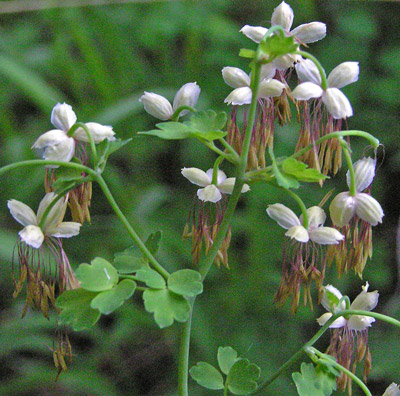Thalictrum
|
Family: Ranunculaceae |
Herbs , perennial, from woody rhizomes, caudices, or tuberous roots. Leaves basal and cauline, proximal leaves petiolate, distal leaves sessile; cauline leaves alternate. Leaf blade 1-4×-ternately or -pinnately compound; leaflets cordate-reniform, obovate, lanceolate, or linear, sometimes 3-lobed or more, margins entire or crenate. Inflorescences terminal, sometimes also axillary, (1-)2-200-flowered panicles, racemes, corymbs, umbels, or flowers solitary, to 41 cm; involucres absent or present, involucral bracts 2-3 (these compound, often resembling whorl of 6-9 simple bracts), leaflike, not closely subtending flowers. Flowers all bisexual, bisexual and unisexual on same plant, or all unisexual with sexes on same or different plants, radially symmetric; sepals not persistent in fruit, 4-10, whitish to greenish yellow or purplish, plane, lanceolate to reniform or spatulate, 1-18 mm; petals absent; stamens 7-30; filaments filiform to clavate or distally dilated; staminodes absent between stamens and pistils; pistils 1-16, simple; ovule 1 per pistil; style present or absent. Fruits achenes, usually aggregate, sessile or stipitate, ovoid to obovoid, falcate, or discoid, sides prominently veined or ribbed; beak present or absent, terminal, straight to coiled, 0-4 mm. x = 7. Thalictrum is a taxonomically difficult genus that should be carefully researched through additional population-based field studies. Past treatments of Thalictrum have often emphasized leaf characters that are highly variable in most species; they are therefore of poor diagnostic value and not indicative of true relationships. Because of the paucity of field studies and a continuing emphasis on highly variable characters, the literature is replete with names that do not represent distinct entities. Often mixes of character states can be found within a single population; many of the character states used in past studies were neither ecologically nor geographically distinct. Some species of Thalictrum have been divided into varieties by previous authors. In the absence of carefully collected, supporting evidence from field studies, we are unwilling to perpetuate the use of any infraspecific names. Characters useful in identifying species of Thalictrum include leaflet shape, degree of dilation of filaments, anther length, shape of anther apex, achene shape and venation patterns, and vestiture (glands and/or hairs) of leaves and achenes. Leaflets described in this treatment are the central, distalmost of a midstem leaf; proximal and distal leaves are more variable and often not representative of the species. Stigma and filament colors refer to fresh material in the following descriptions. In Thalictrum species, the stigma extends down the side of the style, so length of style in fruit (beak) includes the stigma. For many species no reliable characteristics for the identification of staminate material are known. Extensive field work and careful analysis are required to determine if such characteristics exist. In a narrow strip from southeastern Ontario to Ohio to Louisiana, some individuals of some species in Thalictrum section Leucocoma may lack their normal vestiture. In the absence of glands or pubescence, the differences among species are difficult to describe. The remaining characteristics overlap considerably. The species involved may be identified in the final couplets of the key as follows: if the plant in hand falls into the area of overlap for the first character of the couplet, go on to the next character, and so forth, until a distinguishing character is found. One or more of the characters offered should distinguish the infrequent, problematic individual. Several species of Thalictrum are used as ornamentals. At least one species, T . aquilegiifolium Linnaeus, occasionally escapes cultivation in Ontario and Quebec and possibly elsewhere. The plant is tall (40-100 cm); flowers bisexual, mauve to pink; and achenes few, filiform, 3-winged, stipitate, very small, and hidden at anthesis among the bases of long, rigid stamens. Numerous alkaloids have been identified from plants of the genus, some with pharmacologic potential. Some exhibit antimicrobial activity; others inhibit growth of tumors or lower blood pressure in mammals.
Fls perfect or more often unisexual; plants hermaphrodite, dioecious, or polygamo-dioecious; sep 4-5, green or petaloid, soon deciduous; pet none; filaments elongate, capillary to clavate or much dilated; ovaries several, 1-seeded; style very short; stigma elongate; achenes usually conspicuously veined or ribbed, sometimes stipitate; perennial herbs with ternately decompound lvs and most ample terminal panicles of greenish, yellowish, purplish, or white fls, the color due principally to the stamens; polyploid series based on x=7. 50+, mostly N. Temp. Gleason, Henry A. & Cronquist, Arthur J. 1991. Manual of vascular plants of northeastern United States and adjacent Canada. lxxv + 910 pp. ©The New York Botanical Garden. All rights reserved. Used by permission. |

